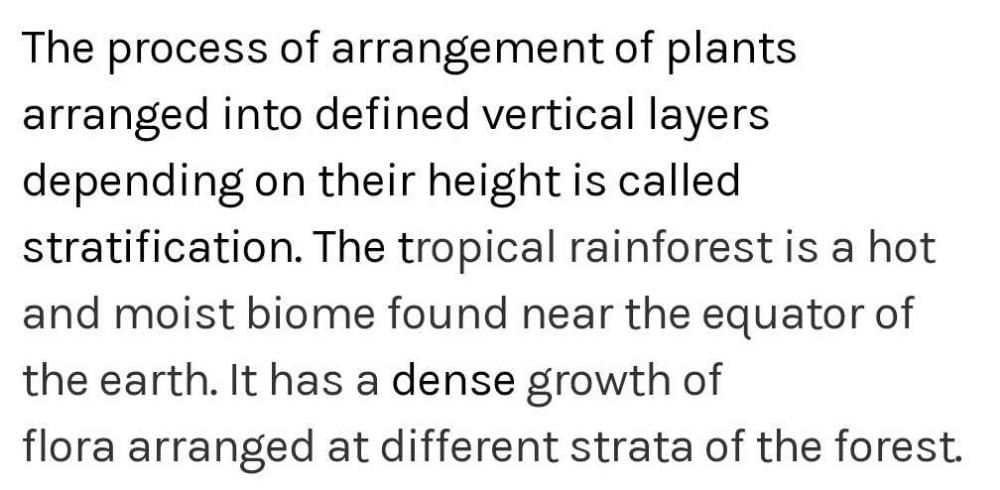NEET Exam > NEET Questions > Stratification is best seen in which biome : ...
Start Learning for Free
Stratification is best seen in which biome : a) Tropical rain forest b)Grass land c) Alpine tundra d)Arctic tundra Plz give explanation and relationship of stratification with biome.?
Most Upvoted Answer
Stratification is best seen in which biome : a) Tropical rain forest b...

Community Answer
Stratification is best seen in which biome : a) Tropical rain forest b...
Stratification in Biomes
Stratification refers to the vertical layering of different vegetation types within a biome. Each layer has its own unique set of plants and animals that are adapted to the specific conditions of that layer.
Tropical Rainforest
In tropical rainforests, stratification is very prominent. The canopy layer consists of tall trees that create a dense covering, allowing limited sunlight to reach the forest floor. Below the canopy is the understory layer, which consists of smaller trees, shrubs, and vines. The forest floor is the lowest layer, where only small plants and decomposers thrive due to the lack of sunlight.
Grassland
Grasslands also exhibit stratification, with different layers of vegetation adapted to the local climate. Tall grasses dominate the upper layer, while shorter grasses and wildflowers make up the middle layer. The lowest layer consists of mosses and lichens that grow close to the ground.
Alpine Tundra
In alpine tundras, stratification is evident due to the harsh conditions at high altitudes. The upper layer consists of low-growing shrubs and grasses that are adapted to cold temperatures and strong winds. The middle layer may have patches of bare rock or snow, while the lowest layer is home to mosses, lichens, and small flowering plants.
Arctic Tundra
Arctic tundras also display stratification, with a similar pattern of vegetation layers as alpine tundras. The upper layer consists of hardy shrubs and grasses, while the middle layer may have patches of permafrost or snow. The lowest layer is characterized by mosses, lichens, and small flowering plants that can survive in the cold, harsh environment.
Overall, the presence of stratification in different biomes reflects the diverse adaptations of plants and animals to specific environmental conditions. Each layer plays a crucial role in maintaining the overall balance and biodiversity of the ecosystem.

|
Explore Courses for NEET exam
|

|
Stratification is best seen in which biome : a) Tropical rain forest b)Grass land c) Alpine tundra d)Arctic tundra Plz give explanation and relationship of stratification with biome.?
Question Description
Stratification is best seen in which biome : a) Tropical rain forest b)Grass land c) Alpine tundra d)Arctic tundra Plz give explanation and relationship of stratification with biome.? for NEET 2025 is part of NEET preparation. The Question and answers have been prepared according to the NEET exam syllabus. Information about Stratification is best seen in which biome : a) Tropical rain forest b)Grass land c) Alpine tundra d)Arctic tundra Plz give explanation and relationship of stratification with biome.? covers all topics & solutions for NEET 2025 Exam. Find important definitions, questions, meanings, examples, exercises and tests below for Stratification is best seen in which biome : a) Tropical rain forest b)Grass land c) Alpine tundra d)Arctic tundra Plz give explanation and relationship of stratification with biome.?.
Stratification is best seen in which biome : a) Tropical rain forest b)Grass land c) Alpine tundra d)Arctic tundra Plz give explanation and relationship of stratification with biome.? for NEET 2025 is part of NEET preparation. The Question and answers have been prepared according to the NEET exam syllabus. Information about Stratification is best seen in which biome : a) Tropical rain forest b)Grass land c) Alpine tundra d)Arctic tundra Plz give explanation and relationship of stratification with biome.? covers all topics & solutions for NEET 2025 Exam. Find important definitions, questions, meanings, examples, exercises and tests below for Stratification is best seen in which biome : a) Tropical rain forest b)Grass land c) Alpine tundra d)Arctic tundra Plz give explanation and relationship of stratification with biome.?.
Solutions for Stratification is best seen in which biome : a) Tropical rain forest b)Grass land c) Alpine tundra d)Arctic tundra Plz give explanation and relationship of stratification with biome.? in English & in Hindi are available as part of our courses for NEET.
Download more important topics, notes, lectures and mock test series for NEET Exam by signing up for free.
Here you can find the meaning of Stratification is best seen in which biome : a) Tropical rain forest b)Grass land c) Alpine tundra d)Arctic tundra Plz give explanation and relationship of stratification with biome.? defined & explained in the simplest way possible. Besides giving the explanation of
Stratification is best seen in which biome : a) Tropical rain forest b)Grass land c) Alpine tundra d)Arctic tundra Plz give explanation and relationship of stratification with biome.?, a detailed solution for Stratification is best seen in which biome : a) Tropical rain forest b)Grass land c) Alpine tundra d)Arctic tundra Plz give explanation and relationship of stratification with biome.? has been provided alongside types of Stratification is best seen in which biome : a) Tropical rain forest b)Grass land c) Alpine tundra d)Arctic tundra Plz give explanation and relationship of stratification with biome.? theory, EduRev gives you an
ample number of questions to practice Stratification is best seen in which biome : a) Tropical rain forest b)Grass land c) Alpine tundra d)Arctic tundra Plz give explanation and relationship of stratification with biome.? tests, examples and also practice NEET tests.

|
Explore Courses for NEET exam
|

|
Signup for Free!
Signup to see your scores go up within 7 days! Learn & Practice with 1000+ FREE Notes, Videos & Tests.
























